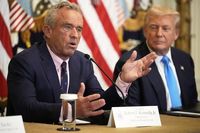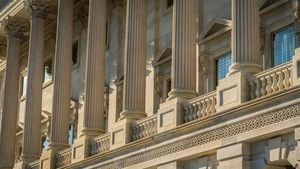Public health and media organizations across the United States are reeling from a wave of federal funding cuts, with consequences rippling through communities large and small. The latest blows, delivered in the summer of 2025, have forced layoffs, program reductions, and legal battles that underscore the deep political and economic divides shaping America’s public safety net.
On August 27, 2025, Vermont Public—a joint NPR and PBS station—announced the layoff of 15 employees, amounting to 14 percent of its staff, after President Trump signed a bill in July rescinding $1.1 billion in federal support for public media. According to Vermont Public chief executive Vijay Singh, the station now faces a $2 million annual budget gap. "This was a heartbreaking decision to make," Singh said in a statement, emphasizing, "Our people are central to our service, and today we are losing talented, dedicated colleagues who put mission and community first. We made every effort to align these reductions with our long-term priorities and opportunities for service."
The impact extends far beyond Vermont. As The Boston Globe reported, other New England public media organizations have also been forced to make painful choices. GBH, the Boston-based media powerhouse, laid off 13 employees from its PBS history program American Experience in July due to the same federal funding cuts, after already trimming 7 percent of its staff earlier in the year. Ocean State Media in Rhode Island offered buyouts and warned of impending layoffs just a week before Vermont Public’s announcement.
At Vermont Public, the now-shuttered Corporation for Public Broadcasting had previously provided about 10 percent of the station’s annual revenue. In a phone interview, Singh acknowledged that while no programs were being cut at the moment, he couldn’t "make any promises about what’s ahead" given the station’s precarious financial future. The organization had already implemented a series of cost-saving measures—cutting back on travel, conferences, and software, as well as trimming executive compensation—before resorting to layoffs and converting two full-time positions to part-time roles. Singh noted that no further cuts are anticipated in the short term, but the long-term outlook remains uncertain.
These developments are not isolated. Across the country, public health infrastructure is facing similar threats. According to a KFF Health News analysis published on August 26, 2025, the Trump administration’s cuts to Centers for Disease Control and Prevention (CDC) funding for state and local health departments have had vastly uneven effects, depending in large part on the political leadership of each state. In late March, the Department of Health and Human Services canceled nearly 700 CDC grants nationwide—worth about $11 billion—that had been awarded during the COVID-19 pandemic to support vaccination, reduce health disparities, upgrade disease detection systems, and hire community health workers.
Initially, both Democratic and Republican-led states were hit roughly equally. Four of the five jurisdictions with the largest number of terminated grants—California, the District of Columbia, Illinois, and Massachusetts—were led by Democrats. But the landscape shifted dramatically after attorneys general and governors from about two dozen blue states sued in federal court and won injunctions. As a result, nearly 80 percent of the CDC grant cuts were restored in blue states, compared to fewer than 5 percent in red states. States like Texas, Georgia, Oklahoma, and Ohio—led by Republicans—ended up with the highest number of canceled grants after the court’s intervention.
The funding in question was not limited to COVID-19 relief. Public health experts told KFF Health News that the grants also supported basic infrastructure and efforts to contain a wide range of diseases, from measles to RSV. Susan Kansagra, chief medical officer of the Association of State and Territorial Health Officials, explained, "It really supported infrastructure across the board, particularly in how states respond to public health threats." The timing could hardly be worse: the U.S. is grappling with its largest measles outbreak in more than three decades and a deadly flu season that claimed 266 pediatric lives—the highest toll outside of a pandemic since 2004.
As grants dried up, public health departments were forced to cancel vaccine clinics, lay off staff, and put essential contracts on hold. In Jackson, Ohio, Health Commissioner Kevin Aston described the abrupt loss of funding: "I had to lay off three employees in a single day, and I haven't had to do that before. We don't have those people doing outreach in Jackson County anymore." The funding had previously supported 11 Appalachian Ohio counties; now, only one remains covered. Marsha Radabaugh, a reassigned employee, recounted how she had helped deliver meals and connect homeless clients to services, noting, "We would find them rehab places. We'd get out hygiene kits, blankets, tents, zero-degree sleeping bags, things like that."
Columbus, Ohio, lost $3 million in CDC grants and laid off 11 employees who had worked on infectious disease investigations in schools and nursing homes. Columbus Health Commissioner Mysheika Roberts said, "We've never had a grant midcycle just get pulled from us for no reason. This sense of uncertainty is stressful." The city had planned to upgrade its electronic health record system to improve disease detection, but those plans are now on hold. Roberts added that, even though a federal judge has since blocked the cuts and Columbus is awaiting restored funds, the city does not plan to rehire staff because the funding is expected to end in December.
Health officials warn that the loss of CDC funding—which accounts for more than half the budgets of many state and local health departments, according to KFF—could leave communities dangerously unprepared for future outbreaks. Brent Ewig, chief policy and government relations officer for the Association of Immunization Managers, described the situation as "the predictable result of 'boom, bust, panic, neglect' funding" for public health. He cautioned, "The system is blinking red."
The cuts have also intensified political polarization over health care and public media in the U.S. As KFF Health News observed, access to vital health programs, abortion rights, and the ability of officials to respond to disease threats now diverge sharply depending on which party holds power in a given state. Some critics, like Joe Grogan, a former Trump White House official, argue that state and local agencies "are not entitled" to federal money that was awarded "to deal with an emergency" now considered over. Others, like HHS spokesperson Andrew Nixon, maintain that the agency "is committed to protecting the health of every American, regardless of politics or geography."
Back in Vermont, the future of public media remains cloudy. While no programs have been cut yet, Vermont Public’s Singh admitted that the station faces long-term challenges without federal funding. The story is much the same for public health departments nationwide, where the loss of federal grants has left many scrambling to maintain essential services. As health departments and media organizations alike brace for further uncertainty, the stakes for communities across the country have never felt higher.




